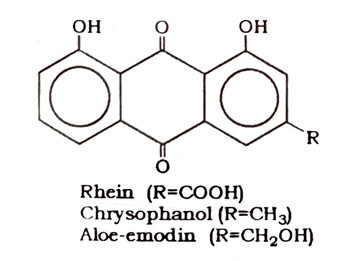Synonyms:
Rheum, Rhei Rhizoma, Rhei Radix, Rhubarb Rhizome
Botanical source:
Rhubarb consists of the dried peeled rhizome of various Rheum species, particularly Rheum palmatum Linn. and Rheum Officinale Baillon, but not of Rheum rhaponticum Linn. These plants belong to the family Polygonaceae.
Geographical source:
The principal geographical sources of Rhubarb are China and Tibet where the plants grow abundantly.

Fig. 64: Rhubarb. A, peeled rhizome; B, transversely cut surface of rhizome· C, t.s. through fundamental parenchyma a starch; c, cambium; cr. cluster crystals of calcium oxalate; ph, phloem; r, reticulation; s.p., star-spots; spl, star-spot spl star-spot cut longitudinally; xy, secondary xylem. (Reconstructed from Wallis)
Macroscopical characters:
The rhizome is sub-cylindrical, barrel-shaped, conical or plano-convex in shape, 3 to 12 cm long and 3 to 8 cm 1n diameter. The drug often occurs in pieces, described as ‘flats’ or ’rounds’. The surface shows a network of reddish brown lines embedded in a whitish matrix and numerous ‘star-spots’. It is generally orange brown in colour and has an uneven granular fracture. The transversely cut surface exhibits a prominent cambium line near the periphery, a ring of star spots and a radiate structure. The drug has a characteristic aromatic odour and a bitter, slightly astringent and gritty taste.
Macroscopical characters:
Cork and cortical cells are absent. The phloem tissue, which consists of abundant phloem parenchyma and mostly obliterated sieve tubes, is traversed by 3 to 5 cells wide medullary rays. The medullary ray cells are filled with a reddish brown substance. The phloem parenchyma contains both simple and compound starch grains with well-marked hila. Xylem tissue occurs as a narrow ring within the cambium and is composed of numerous reticulate, non-lignified groups of vessels and single vessels. Adjacent to the inner margin of the xylem is a circle of abnormal vascular bundles (the star spots), which have a phloem in the centre and xylem on the outside of the cambium. The pith is well developed and is traversed by stellate bundles of medullary rays filled with a reddish brown substance. The pith -cells contain starch grains and very large clusters and rosettes of calcium oxalate crystals.
Chemical constituents:
Rhubarb mainly contains 2.0 to 4.5 percent of anthraquinone glycosides, which include aloe-emodin, chrysophanol, physcion, rhein and their derivatives. In addition to these glycosides, Rhubarb also contains glucogallin, eallic acid, rheinotannic acid, .catechin, starch, sugars, fat, pectin and calcium oxalate.

Uses:
Rhubarb is used as a laxative drug. In larger doses it causes purgation. In smaller doses it is a bitter stomachic and intestinal astringent. It is also given in cases of indigestion with diarrhoea.
Substitutes and adulterants:
English Rhubarb (Rheum Officinale) and Indian Rhubarb (Rheum emodz) are used as substitutes, while Rhapontic Rhubarb (Rheum rhaponticum) and the stock roots of Rumex alpinus and Rumex obtusifolius are used as adulterants of the official drug.
